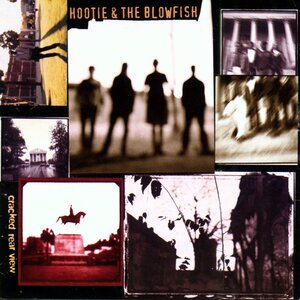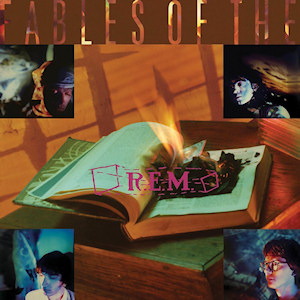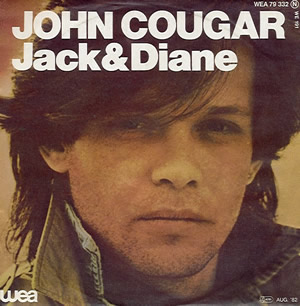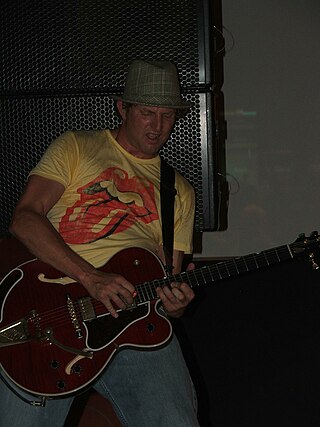Related Research Articles

Hootie & the Blowfish is an American rock band formed in Columbia, South Carolina, in 1986. The band's lineup for most of its existence has been the quartet of Darius Rucker, Mark Bryan, Dean Felber, and Jim Sonefeld. The band went on hiatus in 2008 until they announced plans for a full reunion tour in 2019 and released their first new studio album in fourteen years, Imperfect Circle.

Cracked Rear View is the debut studio album by Hootie & the Blowfish, released on July 5, 1994, by Atlantic Records. Released to positive critical reviews, it eventually sold 10.2 million copies in the United States, becoming one of the best-selling albums of all time.

Fables of the Reconstruction is the third studio album by American alternative rock band R.E.M. It was released on June 10, 1985 through I.R.S. Records. It was the band's first album recorded outside of the U.S., with sessions taking place at Livingston Studios in London with producer Joe Boyd. The record displays a darker, murkier sound and lyrics drawing from Southern Gothic themes and characters. Additionally, more varied instrumentation is utilized, including string and brass arrangements and banjo.

The dB's are an American alternative rock and power pop group, who formed in New York City in 1978 and first came to prominence in the early 1980s. Their debut album Stands for Decibels is acclaimed as one of the great "lost" power pop albums of the 1980s.

Lifes Rich Pageant is the fourth studio album by the American alternative rock band R.E.M., released on July 28, 1986. R.E.M. chose Don Gehman to produce the album, which was recorded at John Mellencamp's Belmont Mall Studio in Belmont, Indiana. This was the only album the band recorded with Gehman, who moved them from the more obscure and dense sound of their earlier albums to an accessible, hard rock-influenced quality. The album was well-received critically.

"Jack & Diane" is a song written and performed by American singer-songwriter John Mellencamp, then performing as "John Cougar." Described by critics as a "love ballad", this song was released as the second single from Mellencamp's 1982 album American Fool, and was chosen by the Recording Industry Association of America (RIAA) as one of the Songs of the Century. It spent four weeks at number one on the Billboard Hot 100 in 1982 and is Mellencamp's most successful hit single.

Looking for Lucky is the fifth studio album by American rock band Hootie & the Blowfish, released on August 9, 2005. The album sold 128,000 copies in the U.S. up to March 2009.

The Lonesome Jubilee is the ninth studio album by American singer-songwriter John Mellencamp, credited as John Cougar Mellencamp. The album was released by Mercury Records on August 24, 1987. Four singles were released from the album, the first two in 1987 and the last two in 1988.
Criteria Studios is a recording studio in North Miami, Florida, founded in 1958 by musician Mack Emerman. Hundreds of gold, platinum, and diamond singles and albums have been recorded, mixed or mastered at Criteria, for many notable artists and producers.

Mark William Bryan is an American musician. He is a founding member, songwriter, and lead guitarist for the band Hootie & the Blowfish. In 1986, Bryan and his friend Darius Rucker formed a duo called the Wolf Brothers while attending the University of South Carolina. Eventually, friends Dean Felber and Jim Sonefeld joined the band, which led to the founding of Hootie & the Blowfish in 1989. Bryan has also released three solo albums: 30 on the Rail, End of the Front, and Songs of the Fortnight.

Cut is the seventh studio album by the Australian rock band, Hunters & Collectors. It was mostly produced by American Don Gehman with the group and issued by White Label/Mushroom on 5 October 1992. It reached No. 6 on the ARIA Albums Chart and No. 17 on the New Zealand Albums Chart. The band were nominated for Best Group at the 1992 ARIA Music Awards and Album of the Year for Cut in the following year.

Live in the X Lounge is a series of albums released by Birmingham, Alabama's former alternative rock radio station, WRAX.
Fairweather Johnson is the second studio album by American rock band Hootie & the Blowfish, released on April 23, 1996, through Atlantic Records. Three songs from the album were released as singles: "Old Man & Me", "Tucker's Town", and "Sad Caper". The album debuted at number one on the Billboard 200 in May 1996, while their debut, Cracked Rear View, was still in the charts. It has sold 2,361,000 copies in the US as of May 2012. Despite its initial success, sales tapered off quickly, and the album earned mixed reviews. It was included in Pitchfork Media's 2010 list of "ten career-killing albums" of the 1990s. Stylus Magazine shared sentiments, including it in their "Non-Definitive Guide to the Follow-Up", saying "really, everyone saw this one coming a mile off. Who was really gonna care about another Hootie album?"
Musical Chairs is the third studio album by American rock band Hootie & the Blowfish, released on September 15, 1998, by Atlantic Records. Three singles were released off the album: "I Will Wait", "Only Lonely", and "Wishing". Guest musicians on the album include Peter Holsapple, Susan Cowsill, David Immergluck, and Boyd Tinsley.

R.E.M. was an American rock band from Athens, Georgia, formed in 1980 by drummer Bill Berry, guitarist Peter Buck, bassist Mike Mills, and lead vocalist Michael Stipe, who were students at the University of Georgia. One of the first alternative rock bands, R.E.M. was noted for Buck's ringing, arpeggiated guitar style; Stipe's distinctive vocal quality, unique stage presence, and obscure lyrics; Mills's melodic bass lines and backing vocals; and Berry's tight, economical drumming style. In the early 1990s, other alternative rock acts such as Nirvana and Pavement viewed R.E.M. as a pioneer of the genre. After Berry left the band in 1997, the band continued its career in the 2000s with mixed critical and commercial success. The band broke up amicably in 2011 with members devoting time to solo projects after having sold more than 90 million albums worldwide and becoming one of the world's best-selling music acts.

Kootchypop is a 1993 EP by Hootie & the Blowfish released independently. Several of the EP's songs became hits when they were re-recorded for their later major-label albums. In addition, the tracks were eventually remastered and included as a bonus on the deluxe 25th anniversary edition of Cracked Rear View.

Nick Brophy is an American mixer, sound engineer, record producer and songwriter. The artists he has collaborated with and written for include Jason Aldean, the Rolling Stones, Avril Lavigne, Hootie & the Blowfish, Kenny Chesney, Carly Simon, Taylor Swift, Garbage and Everclear. His engineering credits include Everclear's platinum Sparkle and Fade, Avril Lavigne's 6× platinum Let Go and the Rolling Stones 4× platinum 40 Licks. His mixing credits include three consecutive #1 singles by Kip Moore; 2× platinum Somethin' 'Bout a Truck, certified gold Beer Money and platinum Hey Pretty Girl, as well as Jimmy Fallon's Blow Your Pants Off, for which he won a Grammy. His songwriting credits include recordings by Hootie & the Blowfish, Jason Aldean, Kenny Chesney and Rascal Flatts.
The Blue Dogs are a band formed in 1987 by Bobby Houck and Hank Futch, based in Charleston, South Carolina. Known for their American roots sound and interactive performances, the band has become a staple in southern live entertainment and the Americana scene.

Imperfect Circle is the sixth studio album by American rock band Hootie & the Blowfish, released on Capitol Records Nashville on November 1, 2019. It is their first new studio album in fourteen years; it has received mixed reviews and modest commercial success.
Belmont Mall Studio is a recording studio in Belmont, Indiana, United States. Located on West Lower Schooner Road, it was founded in 1984 by John Mellencamp. Albums which have been recorded there include John Mellencamp's Scarecrow (1985) and R.E.M.'s Lifes Rich Pageant (1986). R.E.M. chose the studio because they wanted to work with Mellencamp's producer, Don Gehman, who built the studio.
References
- 1 2 3 4 5 6 7 8 9 10 11 12 13 14 Ankeny, Jason. "Don Gehman Biography". AllMusic. Retrieved 2022-06-22.
- 1 2 3 Massey, Howard (2009). "Don Gehman: From a Cougar to a Hootie". Behind the Glass: Top Record Producers Tell How They Craft the Hits. Rowman & Littlefield. p. 82. ISBN 978-1-61774-936-0.
- 1 2 3 4 5 6 7 8 9 10 11 12 13 14 Sommer, Tim (2002). Only Wanna Be with You: The Inside Story of Hootie & the Blowfish. Columbia, South Carolina: University of South Carolina Press. pp. 100–102. ISBN 978-1-64336-276-2.
- 1 2 3 4 5 6 7 8 9 "The Interview With Hootie Producer: Don Gehman". hootie4life.tripod.com. Retrieved 2022-06-22.
- 1 2 3 4 Farinella, DavidJohn (2010-03-15). Producing Hit Records: Secrets from the Studio. Schirmer Trade Books. ISBN 978-0-85712-510-1.
- 1 2 3 4 5 6 7 8 9 10 Schultz, Barbara (2000). "Don Gehman: Nice Guys Finish First". Music Producers: Conversations with Today's Top Hit Makers. Hal Leonard Corporation. pp. 174–176. ISBN 978-0-87288-730-5.
- 1 2 3 4 5 6 7 8 9 10 11 12 13 14 15 16 "Don Gehman | Credits". AllMusic. Retrieved 2022-06-22.
- ↑ Rees, Paul (2021). Mellencamp. Simon and Schuster. p. 55. ISBN 978-1-9821-1216-5.
- ↑ Rees, Paul (2021). Mellencamp . Simon and Schuster. p. 67. ISBN 978-1-9821-1216-5.
- 1 2 3 Rees, Paul (2021). Mellencamp . Simon and Schuster. p. 79. ISBN 978-1-9821-1216-5.
- 1 2 3 4 5 6 7 8 9 10 11 12 Black, Johnny (2004). Reveal: The Story of R.E.M. Hal Leonard Corporation. pp. 124-128. ISBN 978-0-87930-776-9.
- 1 2 3 4 5 Black, Johnny (2004). Reveal: The Story of R.E.M. Hal Leonard Corporation. pp. 119–120. ISBN 978-0-87930-776-9.
- 1 2 3 4 5 Zaleski, Annie (July 28, 2016). "How R.E.M. Took a Big Step Forward With 'Lifes Rich Pageant'". Diffuser.fm. Retrieved 2022-06-24.
- 1 2 3 4 5 Fletcher, Tony (2018-04-26). Perfect Circle: The Story of R.E.M. Omnibus Press. ISBN 978-1-78759-083-0.
- ↑ Black, Johnny (2004). Reveal: The Story of R.E.M. Hal Leonard Corporation. pp. 130. ISBN 978-0-87930-776-9.
- 1 2 3 Droney, Maureen. Producer Don Gehman and Engineer Mark Dearnley on Production and Engineering Techniques Archived September 19, 2006, at the Wayback Machine , Mix . Published May 1, 2003. Accessed November 21, 2008.
- 1 2 Anthony, Lisa (October 1992). "Hunters & Collectors - Cut". Rolling Stone Australia . Front Publishers (475). ISSN 1320-0615.
- ↑ Hepfidelity - Diesel | Credits | AllMusic , retrieved 2022-06-24
- 1 2 3 Wheeler, Stephen P. (8 July 2019). "25 Years Ago: The Hootie Story". rokritr.com. Retrieved 2022-06-24.
- ↑ Sommer, Tim (2022). Only Wanna Be with You: The Inside Story of Hootie & the Blowfish. Columbia, South Carolina: Univ of South Carolina Press. pp. 104–105. ISBN 978-1-64336-276-2.
- ↑ Fairweather Johnson - Hootie & the Blowfish | Credits | AllMusic , retrieved 2022-06-24
- ↑ Musical Chairs - Hootie & the Blowfish | Credits | AllMusic , retrieved 2022-06-24
- ↑ Looking for Lucky - Hootie & the Blowfish | Credits | AllMusic , retrieved 2022-06-24
- 1 2 Popper, John; Budnick, Dean (2016-04-05). Suck and Blow: And Other Stories I'm Not Supposed to Tell. Hachette Books. ISBN 978-0-306-82405-0.
- 1 2 3 4 5 6 7 8 "Artist: Don Gehman". Recording Academy Grammy Awards. Retrieved 2022-06-22.